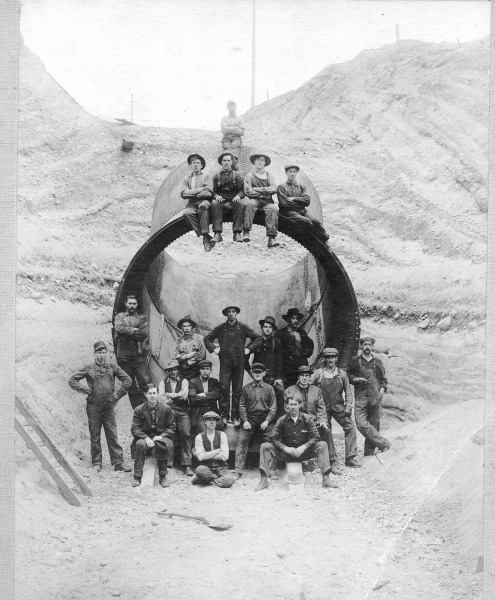
Townsite Heritage Society
The Powell River Story
Paper Pioneers

The town of Powell River itself was preplanned on blueprints as early as 1909. The prime mover behind the town’s development was the Powell River Company, which was responsible for preplanning, constructing and providing for most of the community’s needs.
Once the construction of the pulp and paper mill was underway, construction of the company town began. The construction proceeded methodically, block by block, with up to seven homes being built simultaneously. The progress of the town’s construction depended on the economic conditions of the mill in any given year. The year 1930 marked the completion of the preplanned Garden City.
Philosophical Foundations
The uniqueness and significance of Powell River today can be greatly attributed to the philosophical perspectives of our early cofounders, Dr. Dwight Brooks, Anson Brooks and M.J. Scanlon.
At the time of the Powell River Company’s incorporation in 1909, the prevailing attitude among industrialists could be characterized by an increasing lust for profit and virtually little regard for the working men and women and their families. Degenerating conditions at mines, factories and pulp and paper mills were reflected by increasing squalid and disease-ridden living environments.
Enlightened spokespeople, as early as the late 19th century, decried the workers situation and subsequently formed movements to present alternate ways in which the relationship between employer and employee could be approached.
An influential movement which formed in 1885, to address the problems associated with industrialization at the time called itself The Garden City Movement. The gentlemen of the society conducted research and published their findings for preventative measures against industrial town squalor.
The essential components of the Garden City Movement were grounded in basic respect for the humanity of the individual worker and their family. In order to turn around the prevailing attitudes of the time and create a humane environment in industrial towns, four basic principles were established:
- The town was to be entirely preplanned.
- Homes for employees and their families were to be constructed by the employer ensuring that each home had “ample room, ample air and a place in the yard for a garden”.
- That the entire town was to be surrounded by a green belt of trees or agricultural parkland.
- The town should incorporate to the best advantage a mix of industry, commerce, residential, gardens and green spaces.
The proponents of the movement felt that by preplanning an entire town on principles which enhanced the livability for its residents. the opportunity for a fuller life would be possible, encouraging intellectual, moral and physical development.
Brooks and Scanlon drew from these philosophical movements in the creation of Powell River. The town was preplanned, complete with public gardens and tree-lined streets, all maintained by the Company. Also a tree buffer zone was designated to surround the Townsite and separate it from the neighbourhoods of Westview, Cranberry and Wildwood.
The reason the Powell River Company went to great expense to provide an extraordinary living environment for the community may be explained more concisely by another philosophical movement adopted by the town’s planners at that time. This movement was called the Arts and Craft Movement and arose at the same time as the Garden City Movement.
The Arts and Crafts Movement was not a formalized society as was the Garden City Movement, nor did it have a formalized agenda. It was very loosely structured and had a broad influence in a number of diverse areas, based on three basic principles. These principles can be recognized in Powell River’s Townsite not only by the quality of construction which was undertaken but that the actual designs of the homes from 1909 to 1925 modeled the precepts of the Arts and Crafts Movement.
Firstly, the Movement postulated that the individual would be a better person if he or she were stimulated in the “hand, head and heart”. Further, if a number of individuals were stimulated in this way, a greater good would arise with respect to community and industrial stability and productivity.
Secondly, the Movement extolled the virtue of quality and the therapeutic benefits that flow from creating or being exposed to the highest standards in a wide variety of mediums.
Lastly, the movement re-emphasized a greater appreciation for the natural environment. Objects of art, artefacts, building design and town planning emphasized nature, in contrast to the prevailing trends of Post Victorian sensibilities.